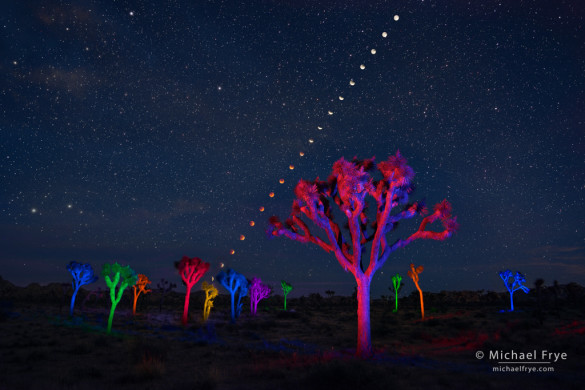
Lunar eclipse sequence with light-painted Joshua trees, September 27th, 2015, Joshua Tree NP, CA, USA
Here, finally, is my photograph of the lunar eclipse on September 27th. We went to Colorado right after this, and then to the eastern Sierra, and in the middle of all that I had to deal with a computer problem, so it’s taken me awhile to put together this sequence.
You might recall that I had planned to go to Death Valley or the Alabama Hills for the eclipse, but a stream of high clouds threatened to block the view, so at the last minute we decided to head further south, away from the clouds, to Joshua Tree National Park.
There were a lot of people there. It seemed to be the spot for eclipse viewing in southern California. But I found less-crowded area with a nice arrangement of “trees” (they’re actually members of the yucca family, and not trees at all) that seemed to line up with the eclipse, and waited for the moon to rise.
Of course it’s hard to calculate these things precisely. When the moon finally rose it was a hair further right than I thought it would be, forcing me to move quickly back and to the left so that the foreground Joshua tree wouldn’t block the moon as it climbed higher.
When the moon cleared the horizon it was almost totally eclipsed. Soon it went into total eclipse, stayed that way for over an hour, and gradually emerged from the eclipse to become full again. I captured a series of images of the moon during this entire sequence, with each exposure ten minutes apart. In the final image, you can see the moon as it first appeared just above the horizon, then higher up as it went into total eclipse (turning orange), and then progressively bigger slices of the moon as it emerged from the eclipse. The top two moons in the sequence were completely full.
In between exposures for the moon I captured more frames as I light-painted the trees. In the old days, with film, I would have used flash and colored gels for this. This time I used a Surefire flashlight, with no gels, and colored the separate light-painting layers later in Photoshop. I also captured a few frames for the background, including some at dusk, and some after dark for the stars.
All the separate frames were blended together in Photoshop using the Lighten blending mode. I also added a few layer masks to blot out some car headlights, and clipped Hue/Saturation adjustment layers (with the Colorize box checked) to the light-painting layers to color the Joshua trees. The background is a blend of two frames: one for the stars, and another taken at dusk to add a bit of blue.
I went a bit wild with the colors on the Joshua trees, but it seemed to fit. I could title this “Alien Landing Zone.” I haven’t used this kind of nighttime color palette in awhile, but I used to do things like this all the time. If you’re not familiar with those images, here’s a link to some of my older nighttime, light-painted images. All but one of these were done on film, mostly using flash and colored gels, though sometimes I used a flashlight. These photographs were made during the late 1990s and early 2000s, except the eclipse, which is from 2007 (that’s also the only digitally-captured image in the group).
Alas, there won’t be another total lunar eclipse visible in North America until 2018. But there will be a total solar eclipse in August of 2017 that can be seen along a narrow path stretching from Oregon to South Carolina. Can’t wait for that!
— Michael Frye
Related Posts: From Eclipse to Aspens; This Sunday’s Lunar Eclipse
Did you like this article? Click here to subscribe to this blog and get every new post delivered right to your inbox!
Michael Frye is a professional photographer specializing in landscapes and nature. He is the author or principal photographer of The Photographer’s Guide to Yosemite, Yosemite Meditations, Yosemite Meditations for Women, Yosemite Meditations for Adventurers, and Digital Landscape Photography: In the Footsteps of Ansel Adams and the Great Masters. He has also written three eBooks: Light & Land: Landscapes in the Digital Darkroom, Exposure for Outdoor Photography, and Landscapes in Lightroom: The Essential Step-by-Step Guide. Michael has written numerous magazine articles on the art and technique of photography, and his images have been published in over thirty countries around the world. Michael has lived either in or near Yosemite National Park since 1983, currently residing just outside the park in Mariposa, California.








